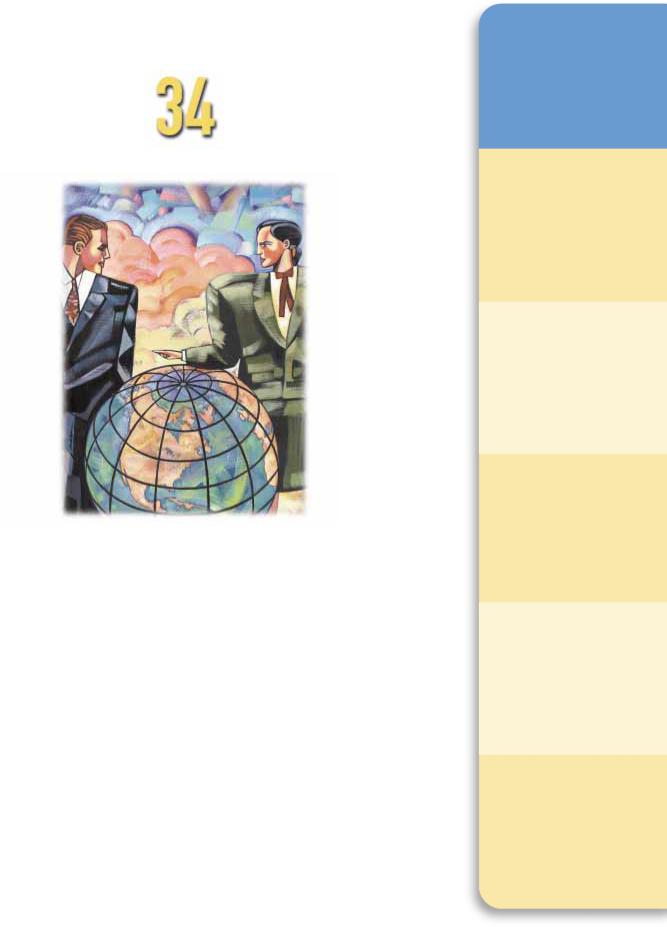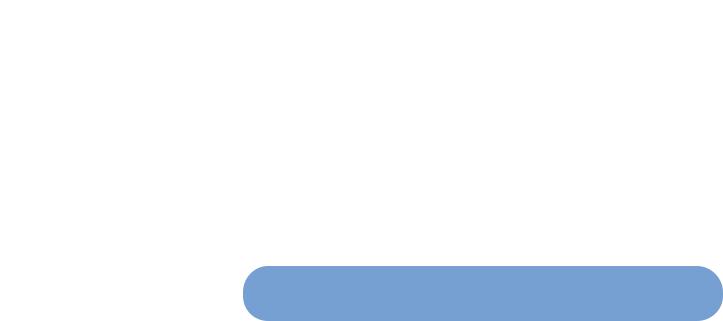CHAPTER 33 THE SHORT-RUN TRADEOFF BETWEEN INFLATION AND UNEMPLOYMENT |
783 |
The rest of the 1990s witnessed a period of economic prosperity. Inflation gradually drifted downward, approaching zero by the end of the decade. Unemployment also drifted downward, leading many observers to believe that the natural rate of unemployment had fallen. Part of the credit for this good economic performance goes to Alan Greenspan and his colleagues at the Federal Reserve, for low inflation can be achieved only with prudent monetary policy. But as the following case study discusses, good luck in the form of favorable supply shocks is also part of the story.
What does the future hold? Macroeconomists are notoriously bad at forecasting, but several lessons of the past are clear. First, as long as the Fed remains vigilant in its control over the money supply and, thereby, aggregate demand, there is no reason to allow inflation to heat up needlessly, as it did in the late 1960s. Second, the possibility always exists for the economy to experience adverse shocks to aggregate supply, as it did in the 1970s. If that unfortunate development occurs, policymakers will have little choice but to confront a less desirable tradeoff between inflation and unemployment.
CASE STUDY WHY WERE INFLATION AND UNEMPLOYMENT
SO LOW AT THE END OF THE 1990S?
As the twentieth century drew to a close, the U.S. economy was experiencing some of the lowest rates of inflation and unemployment in many years. In 1999, for instance, unemployment had fallen to 4.2 percent, while inflation was running a mere 1.3 percent per year. As measured by these two important macroeconomic variables, the United States was enjoying a period of unusual prosperity.
Some observers argued that this experience cast doubt on the theory of the Phillips curve. Indeed, the combination of low inflation and low unemployment might seem to suggest that there was no longer a tradeoff between these two variables. Yet most economists took a less radical view of events. As we have discussed throughout this chapter, the short-run tradeoff between inflation and unemployment shifts over time. In the 1990s, this tradeoff shifted leftward, allowing the economy to enjoy low unemployment and low inflation simultaneously.
What caused this favorable shift in the short-run Phillips curve? Part of the answer lies in a fall in expected inflation. Under Paul Volcker and Alan Greenspan, the Fed pursued a policy aimed at reducing inflation and keeping it low. Over time, as this policy succeeded, the Fed gained credibility with the public that it would continue to fight inflation as necessary. The increased credibility lowered inflation expectations, which shifted the short-run Phillips curve to the left.
In addition to this shift from reduced expected inflation, many economists believe that the U.S. economy experienced some favorable supply shocks during this period. (Recall that a favorable supply shock shifts the short-run aggregate-supply curve to the right, raising output and reducing prices. It therefore reduces both unemployment and inflation and shifts the short-run Phillips curve to the left.) Here are three events that may get credit for the favorable shift to aggregate supply:

784 |
PART TWELVE SHORT-RUN ECONOMIC FLUCTUATIONS |
Declining Commodity Prices. In the late 1990s, the prices of many basic commodities fell on world markets. This fall in commodity prices, in turn, was partly due to a deep recession in Japan and other Asian economies, which reduced the demand for these products. Because commodities are an important input into production, the fall in their prices reduced producers’ costs and acted as a favorable supply shock for the U.S. economy.
Labor-Market Changes. Some economists believe that the aging of the large baby-boom generation born after World War II has caused fundamental changes in the labor market. Because older workers are typically in more stable jobs than younger workers, an increase in the average age of the labor force may reduce the economy’s natural rate of unemployment.
Technological Advance. Some economists think the U.S. economy has entered a period of more rapid technological progress. Advances in information technology, such as the Internet, have been profound and have influenced many parts of the economy. Such technological advance increases productivity and, therefore, is a type of favorable supply shock.
Economists debate which of these explanations of the shifting Phillips curve is most plausible. In the end, the complete story may contain elements of each.
Keep in mind that none of these hypotheses denies the fundamental lesson of the Phillips curve—that policymakers who control aggregate demand always face a short-run tradeoff between inflation and unemployment. Yet the 1990s remind us that this short-run tradeoff changes over time, sometimes in ways that are hard to predict.
QUICK QUIZ: What is the sacrifice ratio? How might the credibility of the
Fed’s commitment to reduce inflation affect the sacrifice ratio?
CONCLUSION
This chapter has examined how economists’ thinking about inflation and unemployment has evolved over time. We have discussed the ideas of many of the best economists of the twentieth century: from the Phillips curve of Phillips, Samuelson, and Solow, to the natural-rate hypothesis of Friedman and Phelps, to the rational-expectations theory of Lucas, Sargent, and Barro. Four of this group have already won Nobel prizes for their work in economics, and more are likely to be so honored in the years to come.
Although the tradeoff between inflation and unemployment has generated much intellectual turmoil over the past 40 years, certain principles have developed that today command consensus. Here is how Milton Friedman expressed the relationship between inflation and unemployment in 1968:
There is always a temporary tradeoff between inflation and unemployment; there is no permanent tradeoff. The temporary tradeoff comes not from inflation per se, but from unanticipated inflation, which generally means, from a rising
CHAPTER 33 THE SHORT-RUN TRADEOFF BETWEEN INFLATION AND UNEMPLOYMENT |
785 |
rate of inflation. The widespread belief that there is a permanent tradeoff is a sophisticated version of the confusion between “high” and “rising” that we all recognize in simpler forms. A rising rate of inflation may reduce unemployment, a high rate will not.
But how long, you will say, is “temporary”? . . . I can at most venture a personal judgment, based on some examination of the historical evidence, that the initial effects of a higher and unanticipated rate of inflation last for something like two to five years.
Today, more than 30 years later, this statement still summarizes the view of most macroeconomists.
Summar y
The Phillips curve describes a between inflation and unemployment aggregate demand, policymakers
the Phillips curve with higher unemployment. By contracting policymakers can choose a point with lower inflation and higher
The tradeoff between inflation described by the Phillips curve run. In the long run, expected changes in actual inflation, and curve shifts. As a result, the long vertical at the natural rate of
The short-run Phillips curve also shocks to aggregate supply. An
in world oil prices during the 1970s, a less favorable tradeoff between
unemployment. That is, after an adverse policymakers have to accept a higher rate
given rate of unemployment, or a unemployment for any given rate of
growth in the money supply to moves the economy along the shortwhich results in temporarily high
cost of disinflation depends on of inflation fall. Some
that a credible commitment to low the cost of disinflation by inducing of expectations.
|
Key Concepts |
|
|
|
|
Phillips curve, p. 763 |
rational expectations, p. 779 |
natural-rate hypothesis, p. 772 |
|
|
|
|
|
Questions for Review |
|
|
|
|
1.Draw the short-run tradeoff between inflation and unemployment. How might the Fed move the economy from one point on this curve to another?
2.Draw the long-run tradeoff between inflation and unemployment. Explain how the short-run and longrun tradeoffs are related.
3.What’s so natural about the natural rate of unemployment? Why might the natural rate of unemployment differ across countries?
4.Suppose a drought destroys farm crops and drives up the price of food. What is the effect on the short-run tradeoff between inflation and unemployment?
5.The Fed decides to reduce inflation. Use the Phillips curve to show the short-run and long-run effects
of this policy. How might the short-run costs be reduced?
786 |
PART TWELVE SHORT-RUN ECONOMIC FLUCTUATIONS |
Problems and Applications
1.Suppose the natural rate of unemployment is 6 percent. On one graph, draw two Phillips curves that can be used to describe the four situations listed below. Label the point that shows the position of the economy in each case:
a.Actual inflation is 5 percent and expected inflation is 3 percent.
b.Actual inflation is 3 percent and expected inflation is 5 percent.
c.Actual inflation is 5 percent and expected inflation is 5 percent.
d.Actual inflation is 3 percent and expected inflation is 3 percent.
2.Illustrate the effects of the following developments on both the short-run and long-run Phillips curves. Give the economic reasoning underlying your answers.
a.a rise in the natural rate of unemployment
b.a decline in the price of imported oil
c.a rise in government spending
d.a decline in expected inflation
3.Suppose that a fall in consumer spending causes a recession.
a.Illustrate the changes in the economy using both an aggregate-supply/aggregate-demand diagram and a Phillips-curve diagram. What happens to inflation and unemployment in the short run?
b.Now suppose that over time expected inflation changes in the same direction that actual inflation changes. What happens to the position of the shortrun Phillips curve? After the recession is over, does the economy face a better or worse set of inflation– unemployment combinations?
4.Suppose the economy is in a long-run equilibrium.
a.Draw the economy’s short-run and long-run Phillips curves.
b.Suppose a wave of business pessimism reduces aggregate demand. Show the effect of this shock on your diagram from part (a). If the Fed undertakes expansionary monetary policy, can it return the economy to its original inflation rate and original unemployment rate?
c.Now suppose the economy is back in long-run equilibrium, and then the price of imported oil rises. Show the effect of this shock with a new diagram like that in part (a). If the Fed undertakes expansionary monetary policy, can it return the
economy to its original inflation rate and original unemployment rate? If the Fed undertakes contractionary monetary policy, can it return the economy to its original inflation rate and original unemployment rate? Explain why this situation differs from that in part (b).
5.Suppose the Federal Reserve believed that the natural rate of unemployment was 6 percent when the actual natural rate was 5.5 percent. If the Fed based its policy decisions on its belief, what would happen to the economy?
6.The price of oil fell sharply in 1986 and again in 1998.
a.Show the impact of such a change in both the aggregate-demand/aggregate-supply diagram and in the Phillips-curve diagram. What happens to inflation and unemployment in the short run?
b.Do the effects of this event mean there is no shortrun tradeoff between inflation and unemployment? Why or why not?
7.Suppose the Federal Reserve announced that it would pursue contractionary monetary policy in order to reduce the inflation rate. Would the following conditions make the ensuing recession more or less severe? Explain.
a.Wage contracts have short durations.
b.There is little confidence in the Fed’s determination to reduce inflation.
c.Expectations of inflation adjust quickly to actual inflation.
8.Some economists believe that the short-run Phillips curve is relatively steep and shifts quickly in response to changes in the economy. Would these economists be more or less likely to favor contractionary policy in order to reduce inflation than economists who had the opposite views?
9.Imagine an economy in which all wages are set in threeyear contracts. In this world, the Fed announces a disinflationary change in monetary policy to begin immediately. Everyone in the economy believes the Fed’s announcement. Would this disinflation be costless? Why or why not? What might the Fed do to reduce the cost of disinflation?
10.Given the unpopularity of inflation, why don’t elected leaders always support efforts to reduce inflation? Economists believe that countries can reduce the cost
792 |
PART THIRTEEN FINAL THOUGHTS |
on the economy. This final chapter presents both sides in five leading debates over macroeconomic policy. The knowledge you have accumulated in this course provides the background with which we can discuss these important, unsettled issues. It should help you choose a side in these debates or, at least, help you see why choosing a side is so difficult.
SHOULD MONETARY AND FISCAL POLICYMAKERS
TRY TO STABILIZE THE ECONOMY?
In Chapters 31, 32, and 33, we saw how changes in aggregate demand and aggregate supply can lead to short-run fluctuations in production and employment. We also saw how monetary and fiscal policy can shift aggregate demand and, thereby, influence these fluctuations. But even if policymakers can influence short-run economic fluctuations, does that mean they should? Our first debate concerns whether monetary and fiscal policymakers should use the tools at their disposal in an attempt to smooth the ups and downs of the business cycle.
PRO: POLICYMAKERS SHOULD TRY
TO STABILIZE THE ECONOMY
Left on their own, economies tend to fluctuate. When households and firms become pessimistic, for instance, they cut back on spending, and this reduces the aggregate demand for goods and services. The fall in aggregate demand, in turn, reduces the production of goods and services. Firms lay off workers, and the unemployment rate rises. Real GDP and other measures of income fall. Rising unemployment and falling income help confirm the pessimism that initially generated the economic downturn.
Such a recession has no benefit for society—it represents a sheer waste of resources. Workers who become unemployed because of inadequate aggregate demand would rather be working. Business owners whose factories are left idle during a recession would rather be producing valuable goods and services and selling them at a profit.
There is no reason for society to suffer through the booms and busts of the business cycle. The development of macroeconomic theory has shown policymakers how to reduce the severity of economic fluctuations. By “leaning against the wind” of economic change, monetary and fiscal policy can stabilize aggregate demand and, thereby, production and employment. When aggregate demand is inadequate to ensure full employment, policymakers should boost government spending, cut taxes, and expand the money supply. When aggregate demand is excessive, risking higher inflation, policymakers should cut government spending, raise taxes, and reduce the money supply. Such policy actions put macroeconomic theory to its best use by leading to a more stable economy, which benefits everyone.
CHAPTER 34 FIVE DEBATES OVER MACROECONOMIC POLICY |
793 |
CON: POLICYMAKERS SHOULD NOT TRY
TO STABILIZE THE ECONOMY
Although monetary and fiscal policy can be used to stabilize the economy in theory, there are substantial obstacles to the use of such policies in practice.
One problem is that monetary and fiscal policy do not affect the economy immediately but instead work with a long lag. Monetary policy affects aggregate demand by changing interest rates, which in turn affect spending, especially residential and business investment. But many households and firms set their spending plans in advance. As a result, it takes time for changes in interest rates to alter the aggregate demand for goods and services. Many studies indicate that changes in monetary policy have little effect on aggregate demand until about six months after the change is made.
Fiscal policy works with a lag because of the long political process that governs changes in spending and taxes. To make any change in fiscal policy, a bill must go through congressional committees, pass both the House and the Senate, and be signed by the president. It can take years to propose, pass, and implement a major change in fiscal policy.
Because of these long lags, policymakers who want to stabilize the economy need to look ahead to economic conditions that are likely to prevail when their actions will take effect. Unfortunately, economic forecasting is highly imprecise, in part because macroeconomics is such a primitive science and in part because the shocks that cause economic fluctuations are intrinsically unpredictable. Thus, when policymakers change monetary or fiscal policy, they must rely on educated guesses about future economic conditions.
All too often, policymakers trying to stabilize the economy do just the opposite. Economic conditions can easily change between the time when a policy action begins and when it takes effect. Because of this, policymakers can inadvertently









